Welcome to unit 2 where we will study early flourishing civs such as Mesopotamia, China and Egypt.
What are the pillars of civilization? (skipping this activity – “civilization” seems like such an outdated term)
Activity to try to figure out which criteria (standards or reasons for making a decision) we might use to judge what is a ‘civilization.’
“Ms. G’s criteria when selecting a meal from a menu at a restaurant is that it is dairy free, has no eggs and no meat.”
CHW3M Pillars of Civilization Charts
MESOPOTAMIA
Mesopotamia Intro

PERSIAT for Mesopotamia
CHW3M_Mesopotamia_Intro_2020-21 (PPT overview)
Fill in PERSIAT for Mesopotamia handout using textbook (page #s are given on it).CHW3M_PERSIAT_Mesopotamia
Introduction to HTC of historical significance and the criteria used to determine significance (that’s why we learned the word criteria).
CHINA
To introduce China, take a look at this PPT overview.
Dragon’s Den Assignment
see side page
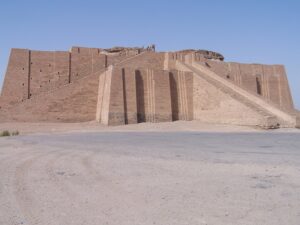
Innovations to choose from:
- cuneiform
- agricultural improvements
- written law code (not a choice but important to note)
- the wheel
- astronomy (calendar)
- Assyrian weaponry
- ziggurats
- math
- porcelain
- silk production
- compass
- seismograph
key words:
social hierarchy (a pyramid shape of social roles, with more status assigned to those at the top than at the bottom; elite = top of social hierarchy), polytheistic (having many gods)
Investigating how a law code reflects the pillars of civ – Hammurabi’s Code and Taizong’s Code.
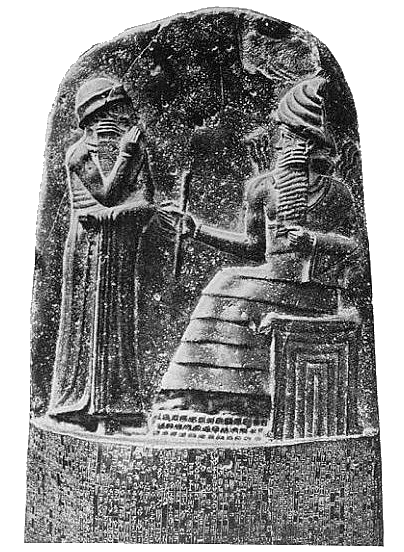
By Milkau_Oberer_Teil_der_Stele_mit_dem_Text_von_Hammurapis_Gesetzescode_369-2.jpg: Luestlingderivative work: Fred the Oyster (talk) – Milkau_Oberer_Teil_der_Stele_mit_dem_Text_von_Hammurapis_Gesetzescode_369-2.jpg, Public Domain, https://commons.wikimedia.org/w/index.php?curid=9812640
Hammurabi’s Code – Primary Source Documents (in handouts) – Read and answer the questions on each handout.
Hammurabi_Code_SHEG (PPT)
HTCs = primary evidence (evidence FROM the time period you’re studying, original), historical perspectives
Vocab and Concepts:
- primary source = something original from the time period being studied
- secondary source = what someone from another time period writes or says about something from a certain time period
- bias = preconceived views/judgments on things (can be positive and/or negative)
- Hammurabi’s biases:
- he thought the gods chose him to rule and gave him the laws
- he was pro-rich
- he was anti-poor to an extent (how much?)
- Hammurabi’s biases:
- context = the situation/environment at the time of an event or document
- polytheistic = a religion with many gods, not just one
- “an eye for an eye” = the principle on which the code was based (supposedly – how true was it for everyone?)
Which pillar of civilization is most reflected by Hammurabi’s Code?
A Closer Look at the Code of Hammurabi (Louvre Museum video) – you may want to watch this for interest.
EGYPT
Intro to the Central Role of Religion in Egyptian Life – Did Religion Help Them Deal with Change?
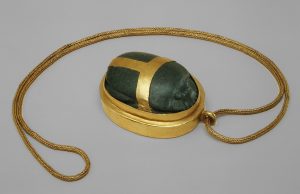
While we will not study everything about Egypt, you should know that their long history can be divided into three main time periods:
The Old Kingdom, approx. 2500-2000 BCE – the pyramid age
The Middle Kingdom, approx. 2000-1500 BCE – prosperity, trade and foreign influence
The New Kingdom, approx. 1500-700 BCE – empire and eventual decline
- within each kingdom there were different dynasties (families of rulers; dynasties were numbered – began with the first dynasty after unification of Upper and Lower Egypt – #1 to 25th. )
TASK: Egyptian_Religion_Inquiry_Amulets
Skill: making inferences from objects
Inferences:
- they were superstitious
- they believed in the afterlife
- they were fearful of not getting into the afterlife
ka = spiritual duplicate PLUS MORE (p. 68 in textbook)
ma’at = the concept of truth, order, harmony, balance, justice (the way things should be) (p. 69 in textbook)
types/evolution of tombs: pit grave, mastaba (bench-like tomb), step pyramid (mastaba stacked upon mastaba), true pyramid (a gigantic advertisement for riches), rock-carved tombs in the Valley of the Kings (they got robbed, too).
TASK: Do the scavenger hunt activity with your group. It contains many links to primary sources (art and other) that are fabulous – it’s like visiting a museum. CHW3M_Egyptian_Religion_Scavenger_Hunt_Oct 2021
Family and Gender and the Case Study of a Female Pharaoh (Hatshepsut)
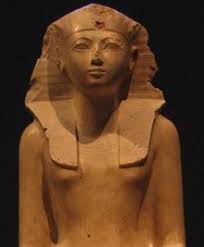
CHW3M_Hatshepsut_2020-21 (PPT) – 3 themes and HTC of continuity and change
- conservative (prefer tradition over change)
- religion is everything
- centralized state
Classes (Egyptian_Classes) and ka recitation are related. A person’s ka recitation would vary depending on what class they were in.
Did religion help Egypt deal with change (a female pharaoh)?
HTC = continuity and change
By now you should be familiar with the basic concepts of Egyptian religion: afterlife, ka, “Book of the Dead”, polytheism (multiple gods), ma’at.
(PPT – contains video links and questions for videos) – 22 – 27 mins.
TASK: complete this worksheet with your group.
- we used this worksheet to analyze how equal Egyptian women were to men, 10 being equal, 0 being not equal at all. The class average seemed to be about ?/10. There is no doubt that Egyptian women had a lot of freedoms that other women in the ancient world did not enjoy. However, even Hatshepsut had to find ways to make herself accepted as a female pharaoh. That’s where ma’at comes in. Stay tuned.
Approved Sites for Hatshepsut:
Hatshepsut (PBS – Egypt’s Golden Empire) Hatshepsut
The Expedition to Punt (PBS – Nova)
The Queen Who Would Be King (Smithsonian)
If you’re curious, read “Hatshepsut and Thutmosis: a royal feud?” (BBC)
3 ways that she tried to persuade Egyptians that she was ruling within maat (the natural order of life).
What does Hatshepsut’s story tell us about Egyptians’ attitudes toward change? (0 = hate change, love tradition, 10= love change)
__________________________________________________________________________
0 5 10
Akhenaton and the Challenge to Egyptian Religion and Art

HTC = continuity and change, historical perspectives (different groups had different views on Akhenaton).
To understand the changes brought by Akhenaton, we need to understand how art was before him. CHW3M_Egyptian_Art_Conventions_2020-21(PPT covers pages 75-76 in textbook)
Akhenaton was the pharaoh who changed:
- the main god (from Amun to Aten)
- art styles
- the capital city
Task: Fill in the T’s and V’s on the “Akhenaton: Tyrant or Visionary” sheet in your handouts. As you watch the video, fill in the worksheet: CHW3M_Akhenaton_Video_Worksheet
Don’t be presentist! You must consider Akhenaton’s actions in the light of ma’at and his own time.
Please note that spelling differs but Amun, Amon, Amen were all the same god. Also note that Akhenaton didn’t invent the Aten (the sun disk god). He just elevated its importance. Aton and Aten are the same god – just different English spelling.
Video: Egypt’s Golden Empire – Pharaoh’s of the Sun (this is an active link to the video on YouTube)
20:45 to 45:00
heretic = someone who goes against accepted religious beliefs
Feel free to read this good summary of Akhenaton’s reign: “Akhenaten: Egyptian Pharaoh, Nefertiti’s Husband, Tut’s Father” (Live Science)
KINGDOM OF KUSH
Egypt’s Foreign Relations with Kush:
https://www.youtube.com/watch?v=CwaP1kyAqqo
7:50 – 11:20 The video starts with ways that Egypt and Kerma (an early Sudanese civilization) influenced each other (not just Egypt being the dominant player in the relationship).
– identify ways that Kerma’s influence has been “overlooked”?
– what were some negative relations?
– what were some positive relations?
– what is the significance and definition of cataracts?
11:20 – 13:50 The Kushites also had impactful relationships with Egypt.
– how did Egyptians refer to Kush?
– when did Kush attack Egypt?
– why was Kush so strategically located for trade?
– which Egyptian rulers wanted to re-establish trade through Kush?
13:50 – 15:55 The area of Napata had religious significance for both Kushites and the Egyptians.
– what is a religious belief associated with the south of Sudan held by both Egyptians and Kushites?
– at this time what was happening in Egypt?
15:55 -21:30 – What are some aspects of daily life from the Napata period that carry over into the present? (note spelling of kohl)
21:30 – 25:00
– what happened to Egypt by the 800s and who took over?
– how did this affect Kushites?
– what did King Kashta do as a result?
25:13 – 36:00
– how were Egyptian and Sudanese pyramids and religious rituals similar and different?
– what did Piankhi do of note regarding Egypt?
– whom did he bring back with him?
– whose attention was raised by the Kushites; military conquests?
– what did Taharqa build of significance at Karnak?
– whose defeat meant the end of the 25th dynasty of Egypt?
Decline of Egypt (not done 2023-25 – would like to reinstate but we’ll see – time is always an issue)
There are certain factors that cause decline. First you will learn what they are, then you will see what actually happened in Egypt’s long decline and how it’s related to the factors.

HTC = causes and consequences (see handout package)
- Note that there are intended consequences and unintended consequences. We will not focus on these categories here.
CHW3M_Decline_of_Egypt_2020-21 (PPT)
Get an overview of why and how Egypt declined by reading the 6 articles. Organize your information into categories (see below).
Here’s one of them: Nat Geo TV Blogs
CHW3M_Decline_of_Egypt_Worksheet-Chart
We are focusing on factors, not dates!
- Akhenaton (18th dynasty) – 1300s BCE
- Ramessides (19th dynasty) – 1200s BCE
- Sea Peoples
- Third Intermediate Period – 1000s BCE
- Nubian control (25th dynasty)
- Assyrian invasion
- Persian invasion – 525 BCE
- Greek control under Ptolemaic Dynasty – 332 BCE
- Roman control – 30 BCE
Remember that there are usually multiple causal factors that lead to something happening.
Factor Categories:
- Long-term
- Medium-term
- Short-term (triggers)
- Internal
- External
- PERSIAT
- Political
- Economic
- Religious
- Social
- Intellectual
- Artistic
- Technological
To help you remember facts about Egypt’s long decline:
Foreigners rubbing salt into self-inflicted wounds.
UDICO: unnecessary change, division, invasion, corruption, overwork
Tribute = payments made to a country for the privilege of trade and friendship of another country. Egypt had become wealthy from tribute.
Links for decline of Egypt:
Egypt: The End of a Civilisation – BBC History
Did Climate Change Lead to the Downfall of Ancient Egypt? Daily Mail
Climate Change May Have Brought Ancient Egypt to its Knees (PBS, Nova)
Egypt in the Third Intermediate Period (Metropolitan Museum)
Other Resources on Decline
Ramses II Colossal Statue (Digital Karnak)
Ramses II (PBS – Egypt’s Golden Empire)
Egypt in the Late Period (Metropolitan Museum)
Ramesses the Great (BBC History)
INDUS VALLEY CIV (haven’t done this for a while due to time issues but it is a very good active learning/student centered activity)
Decline of the Indus Valley Civilization
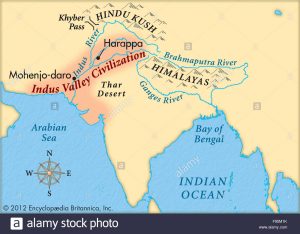
Pillars of civ in Indus Valley:
CHW3M_Indus_Valley_Decline_Causes__Consequences_2020-21 (PPT)
Get a nice overview of the Indus Valley Civ here.
Lots of visuals here.
CHW3M Decline of the Indus Valley Civilization_Theories
CHW3M_Unit2_Indus_Valley_Decline_Activity_2020-21
Links are inside the document.
1.Given all the evidence, what do you think caused the decline of the Indus Valley civ? (could be a combination of theories)
2.What physical evidence are you relying on when you make this determination? (show that you are using criteria)
3.What level of certainty do you have (red light, yellow, green). Use vocabulary accordingly. Note the examples of red light vocabulary on this PPT.